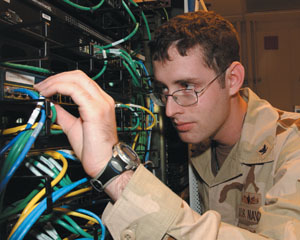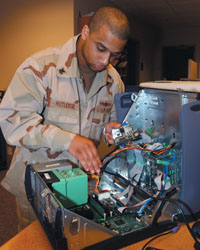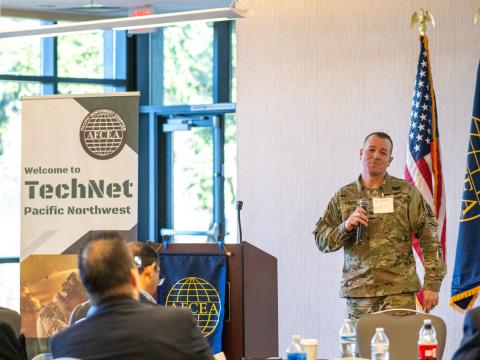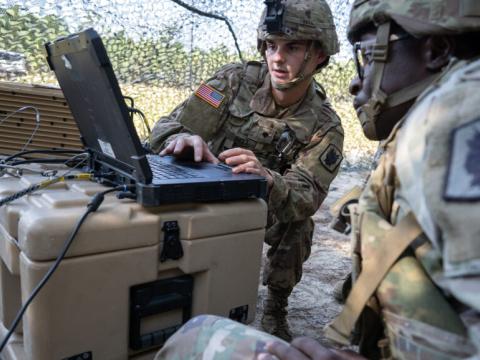Enterprise Network Deploys Overseas
 |
| The initial installation of the outside the continental United States Navy Enterprise Network, or ONE-NET, took place at the U.S. Navy facility in Bahrain. Electronics Tech. 3rd Class Brian Sheppard, USN, checks for connectivity in the server at the Information Technology Service Center of Naval Support Activity Bahrain. |
Lessons learned from Navy/Marine Corps Intranet facilitate installation process.
With updated cabling and server farms in place, the U.S. Navy is making way on a government-owned, government-operated information technology initiative that ultimately will affect more than 41,000 users in Europe, the Middle East and the Far East. During the coming months, sailors stationed at bases outside the continental United States, beyond the scope of the Navy/Marine Corps Intranet, will be coming aboard their own enterprisewide network.
The Naval Network Warfare Command (NETWARCOM), Norfolk, Virginia, is now leading the effort to establish the non-U.S. pillar of FORCEnet by creating a common and secure information technology network on Navy installations outside the continental United States (OCONUS). The OCONUS Navy Enterprise Network, or ONE-NET, will provide state-of-the-art technical capabilities at 16 major OCONUS fleet bases and stations: nine sites in the Far East, six in Europe and one in Bahrain. In addition, ONE-NET will help meet the increased demand for secure Internet protocol router network (SIPRNET) access for forward deployed and support forces.
Although similar in its functionalities to the Navy/Marine Corps Intranet (NMCI) in the United States, ONE-NET differs from the NMCI in one essential way: It is a government-owned and -operated network. General Dynamics Network Systems, Needham Heights, Massachusetts, is under contract for the actual installation; however, NETWARCOM will oversee the day-to-day operation and maintenance of the network, and active duty military personnel, Navy civilians, U.S. contractors and host nations’ citizens will staff the support centers.
Improvements to the infrastructure of the overseas network began in 2001 under the Base Level Information Infrastructure (BLII) program, which was administered by the program executive office for command, control, communications, computers and intelligence, Space and Naval Warfare Systems Command, San Diego. Discussions about moving responsibility for ONE-NET to NETWARCOM began in December 2003, and the command officially assumed the network in October 2004. Personnel and funding are in the final phases of realignment, which is scheduled to be complete by the beginning of fiscal year 2006.
Cmdr. Teresa Bandur-Duvall, USN, deputy chief information officer, NETWARCOM, emphasizes that although the BLII portion of the work referred primarily to updating the infrastructure, the project and ONE-NET encompass much more. “It’s not just the infrastructure. It’s a network. It’s a secure, interoperable, integrated enterprise network. Information assurance is at the forefront of developing the enterprise, not an afterthought,” Cmdr. Bandur-Duvall says.
Eric Markland, consultant for Booz Allen Hamilton, Hampton Roads, Virginia, agrees that improved information security is one of the primary benefits of moving to an enterprisewide network outside the continental United States. “IA [information assurance] is the centerpiece for why we’re doing what we’re doing. We’re going from between 200 and 250 disparate networks worldwide—all with their own processes, all with their own IA suites, all with their own help desks—to one enterprise network,” he states.
The security advantages of having a single network was one of the reasons the Navy decided to move to the NMCI more than four years ago. But ONE-NET resembles the NMCI in a number of other ways. As with the intranet, users will have standardized hardware and software, a centralized help desk, a standardized e-mail address and increased SIPRNET connectivity. In addition, they will be able to access an OCONUS e-mail directory.
Also analogous to the NMCI, ONE-NET is being established incrementally. To date, the Naval Support Activity in Bahrain has migrated onto ONE-NET services, and the cutover was scheduled to take place in Yokosuka, Japan, by the end of February. The initial rollout throughout the OCONUS area is planned to be complete by September 2007.
In terms of hardware and software, ONE-NET users receive Dell computers that feature a 3.2-gigahertz processor, a 40-gigabyte hard drive, 512 megabytes of memory, a compact disc rewriteable/digital versatile disc drive and a two-piece stereo speaker system. Laptop computers with similar features also are available.
Users are provided with a workstation baseline software configuration that includes the Windows XP Professional operating system, Office XP, Internet Explorer, Adobe Acrobat Reader, Visio Viewer, Symantec Corporate Client Edition and a number of multimedia programs. The current plan is to refresh the desktop equipment every three years and the back-room technologies every five years. “That’s a major change from how things are done now because now the age of the computers depends on the command’s budget. So, some have state-of-the-art computers, and some have very old computers,” Markland says.
As ONE-NET is about to be brought to an installation, local information technology staffs will contact all users to schedule the roll over. A ONE-NET migration team will coordinate the process so all users in specific working groups or departments can migrate simultaneously. The amount of time required for the migration will depend on the amount of data that needs to be transferred, but it could take from under an hour to up to 8 hours. Conversions may take place at a user’s workstation or in a migration room, a decision that will be determined by the amount of space available. Once the rollover is complete, users will be required to verify that their data, applications and computer were migrated correctly, and the migration team will be available to familiarize users with the new environment.
ONE-NET will be managed by regional network operating support centers (RNOSCs) and local network operating support centers (LNOSCs). The RNOSCs will handle issues that are specific to a theater such as account, regional network and antivirus management and information assurance vulnerability alert compliance. Markland explains that personnel at the LNOSCs will perform what he calls “touch labor.” When users have a computer problem, they will call an enterprise help desk located at an RNOSC. Solutions will be discussed over the telephone; however, if these fail, a trouble ticket will be sent to the LNOSC in a user’s area and a technician will be dispatched to the command.
 |
| Information Systems Tech. 1st Class Curtis Rutledge, USN, works on a trouble call on a computer at the Information Technology Service Center of Naval Support Activity Bahrain. When ONE-NET users experience problems with their computers, they will first call the help desk located at a regional network operating support center. If the problem cannot be resolved over the telephone, a technician will be sent out from the local network operating support center. |
Despite the similarities, ONE-NET differs from the NMCI in several significant ways. The commander points out that because the intranet is commercially owned and operated, many of the implementation and management decisions are business-based. “If you look at the total cost of ownership, there’s a certain element of the business end to NMCI. A government-owned, government-operated network allows us to take what we learned from a contractor-owned, contractor-operated system, look at it holistically, take the benefits and implement them under the NMCI technique, then use the benefits overseas. Plus, we can use the Status of Forces Agreement to employ in-country personnel to help maintain the system. That allows us to retain civilians in the area and government and military personnel to work on the system,” she states.
The commander notes other benefits as well. “Think about how changes are made. If you want to add a person to the network or look at new technologies, with a government-owned, government-operated network, you don’t have to renegotiate like in NMCI. And, if there’s a mission-critical issue that needs to be addressed immediately, we can look at that right away as a government-owned, government-operated system,” she offers.
Markland points out that the ability to be responsive is one of the reasons it was important to put NETWARCOM in charge of the ONE-NET program. “The command’s mission is to own and operate the networks. We have NMCI here at the command, and we truly have been using lessons learned from NMCI and applying those to make ONE-NET a success.
“Legacy applications are a perfect example. We’ve been through the pain of what it takes to certify, accredit and test these applications. We came up with a policy about a year ago that says, ‘If you are an approved application on NMCI, you are approved on ONE-NET.’ And we’re able to do that because the architecture that ONE-NET was built on matches NMCI,” Markland says. As a result of this policy, the only application issues that need to be resolved are those that are specific to the host nation, he adds.
The commander notes that other lessons were learned from the NMCI project. For example, she believes that the intranet demonstrates that the concept of an enterprise network is a smart idea. “So, one of the lessons we learned was that we weren’t going to have legacy systems out there. We’re providing centralized information assurance, intrusion detection, network monitoring, reporting tools and processes. These are all the things that are NMCI-like. We’ll be able to see any attempts to get into the system now,” she says.
The ONE-NET initiative benefited from the NMCI program in other ways. For example, NMCI implementers found out rather quickly that educating upcoming and new users about the intranet was essential to both usefulness and acceptance. As a result, the ONE-NET team organized a “road show” to explain the enterprise network and processes to its customers. Cmdr. Bandur-Duvall notes that the information was presented not only to flag officers but also to commanders as well as to end users.
The team also asked for information or change agents within the command who would be knowledgeable about ONE-NET. “They won’t pick up the phone and call the help desk, but when someone says, ‘Why can’t I have this on my computer?’ or ‘What will it do to my screen?’ they will get the word out. And they may say, ‘Pick up the phone and call,’” the commander relates.
Although ONE-NET is following an incremental rollout process similar to that of the NMCI, Markland explains that this is another area where experience has been a good teacher. ONE-NET will be installed theater by theater. “You’re not going to see us jump from base to base. We’re taking care of a base when we’re there. I think NMCI came in and did, for example, a command at the Little Creek Naval Amphibious Base and then jumped to another command at the Naval Station in Norfolk. Then they realized, ‘Wow, why didn’t we just take care of Little Creek while we were there?’ So I think everything that we do on ONE-NET ties back to NMCI and the lessons learned, showing that the government can own and operate an enterprise network,” he says.
The commander emphasizes that, like the NMCI, ONE-NET uses standardized hardware and software. “We weren’t trying to go off on our own and be rebels. Under FORCEnet, we have the NMCI, IT-21 and ONE-NET, which is part of the Global Information Grid. We’re trying to ensure that we’re following joint direction through the Defense Department standards and following it through this interoperable network to ONE-NET. So it’s connectivity from the ground up and then from the senior level down. It will be interoperable with NMCI and IT-21,” she states.
Markland points out that this approach allows ONE-NET to remain a government-owned and -operated network or possibly move to a government-owned, contractor-operated or contractor-owned and -operated network if the Navy decides to make a change. “Staying tight with NMCI is a benefit for us because as the Navy evolves, it allows us to adjust to whatever model we want ONE-NET to be in the future,” he notes.
Under the current program, enrolling in ONE-NET is not mandatory. However, under a position established last October called the assistant chief of naval operations for information technology, NETWARCOM personnel expect rules will be put into place that could affect the requirement.
Web Resources
ONE-NET (for military personnel): https://c4isr.spawar.navy.mil/onenet/login.cfm
Network Warfare Command: www.netwarcom.navy.mil
General Dynamics Network Systems: www.gd-ns.com




Comments